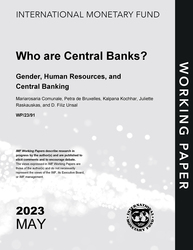
Who are Central Banks? Gender, Human Resources, and Central Banking
Who are Central Banks? Gender, Human Resources, and Central Banking
READ MORE...
Volume/Issue:
Volume 2023
Issue 091
Publication date: May 2023
ISBN: 9798400241208
$20.00
Add to Cart by clicking price of the language and format you'd like to purchase
Available Languages and Formats
| English |
Prices in red indicate formats that are not yet available but are forthcoming.
Topics covered in this book
This title contains information about the following subjects.
Click on a subject if you would like to see other titles with the same subjects.
Labor , Economics- Macroeconomics , Economics / General , Gender Studies , Central banks , gender , human resources , inequality , human resources practice , economics profession , human resources department , HRGI index , gender pattern , gender earnings ratio , Women , Gender inequality , Human capital , Gender diversity , Credit gaps , Global
Also of interest
Summary
Central banks, as the epitome of the economics profession and the main paragon of public institutions, can reveal key insights into gender patterns. We create a novel multidimensional survey directed at eight central banks in advanced economies (G7 national central banks and the European Central Bank), covering several aspects of gender, such as women’s participation at different seniority levels, employment trends, and human resources practices. These elements are summarized in a new comprehensive index of gender equality—Human Resources Gender Index (HRGI). We show that these central banks have room for improvement in the inclusion of women in economics professions, managerial positions, and with full time contracts. Women in central banking also face a gender pay gap. In comparison, International Financial Institutions (the International Monetary Fund, the World Bank Group, and the Organization for Economic Co-operation and Development) perform better in terms of gender equality. The HRGI index, hiring and promotion of women, and their contract types are associated with output and credit gaps, thus being of macro-critical importance. In return, some country characteristics can be related to gender equality, such as women in high-level positions, government effectiveness, and corruption.
Copyright © 2010 - 2026
Powered by:
AIDC



